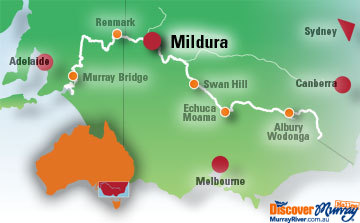
Mildura Riverfront Shared Path - River Bank Erosion
Erosion of river banks is a natural process in a naturally flowing river. Most riverbank erosion in the Murray-Darling Basin occurs during large floods, that is, infrequently. Modelling based on flow rates, riparian vegetation, riverbed slope, and valley width, has predicted erosion rates of the banks of the Murray River around Mildura to be 0.03 to 0.1 metres per year.
Riparian areas are the meeting place between the water and land environment which supports a wide range of animals and plants.
What causes bank erosion?
Riverbank erosion has increased as a result of the decline in riparian vegetation health. Erosion can also be increased by waves caused by recreational boats. Banks can become undercut, and eventually collapse, along with any trees growing on the river’s edge.
Land-based recreation can be a cause of riverbank erosion. In some heavily used areas water runoff is increased, which then flows down the riverbank causing gully erosion. Similarly, vehicle tracks that are well-used and not maintained can lead to erosion of the riverbank. Run-off from roads and tracks is a major source of sediment input to rivers and streams in Victoria. Good native vegetation cover in the riparian area can reduce the potential for these activities to cause erosion.
Prolonged periods of low river water levels can result in cracking and slumping of the river banks. This can have devastating effects – at Long Island Marina in Murray Bridge, four collapse events resulted in historical river red gums being lost as well as several vehicles.
High numbers of rabbits can increase erosion as a result of their digging and burrowing activity. Grazing by rabbits leads to a loss of vegetation cover which can worsen existing erosion.
What are the effects of bank erosion?
Bank erosion is a potential threat to walking tracks, cultural material and other assets located on the river’s edge. It is a significant threat to water quality as it increases sediment and nutrients in the river.
Increase in sediment input into Victorian rivers and streams due to human activities is listed as a threatening process under the Flora and Fauna Guarantee Act 1988. It is a significant threat to a range of flora and fauna, in particular native fish species, which have declined in range and abundance as a consequence.
Sediment input into the river can be minimised through protecting and enhancing native riparian vegetation, particularly on river banks, and minimising flows over land.
What causes bank erosion?
Riverbank erosion has increased as a result of the decline in riparian vegetation health. Erosion can also be increased by waves caused by recreational boats. Banks can become undercut, and eventually collapse, along with any trees growing on the river’s edge.
Land-based recreation can be a cause of riverbank erosion. In some heavily used areas water runoff is increased, which then flows down the riverbank causing gully erosion. Similarly, vehicle tracks that are well-used and not maintained can lead to erosion of the riverbank. Run-off from roads and tracks is a major source of sediment input to rivers and streams in Victoria. Good native vegetation cover in the riparian area can reduce the potential for these activities to cause erosion.
Prolonged periods of low river water levels can result in cracking and slumping of the river banks. This can have devastating effects – at Long Island Marina in Murray Bridge, four collapse events resulted in historical river red gums being lost as well as several vehicles.
High numbers of rabbits can increase erosion as a result of their digging and burrowing activity. Grazing by rabbits leads to a loss of vegetation cover which can worsen existing erosion.
Case Study
River Red Gum
Eucalyptus camaldelensis
The River Red Gum is a medium sized to tall tree usually reaching around 30 metres high, although some have been recorded as being as high as 45 metres high.
They are believed to live to between 500 and 1000 years.
River Red Gums commonly grow in riverine environments and are wide spread throughout Australia. Dead limbs and broken branches provide habitat for many native birds, mammals and reptiles including a variety of cockatoos, parrots, gliders and possums.
Look up and look out for falling limbs
River Red Gums are prone to dropping limbs without warning. The safest place for visitors to the river to enjoy a rest, park their car or have a picnic is in a clear area away from large trees.
Mildura Riverfront Shared Path
Published with permission of Mildura Rural City Council
Tell your friends you found this at murrayriver.com.au!
Copyright Discover Murray 2025. This site or any portion of this site must not be reproduced, duplicated, copied, sold, resold, or otherwise exploited for any commercial purpose that is not expressly permitted by DISCOVER MURRAY.






 DREAMS FLEETWOOD MAC & STEVIE NICKS SHOW
DREAMS FLEETWOOD MAC & STEVIE NICKS SHOW Anh Do The Happiest Refugee Live!
Anh Do The Happiest Refugee Live!

